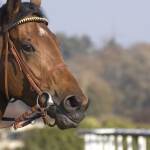Roaring and Choking Down in Horses

These terms are common names for conditions that restrict airflow in the laryngeal area. In both cases, noisy breathing and exercise intolerance are probably the first signs that will alert an owner or trainer to the problem.
What’s wrong with a horse that roars?
As inhaled air goes to the lungs, it passes through the larynx. At the entrance to the larynx are the two arytenoid cartilages, one on either side of the passage. In normal horses, these structures are pulled sideways to widen the airway as the horse takes in air. Roarers, however, suffer from partial or complete paralysis of one (most often the left) or both arytenoid cartilages such that the airway is not able to enlarge and allow air to pass freely. Air rushing through the narrow entrance to the larynx causes a whistling or roaring sound. In severe cases, performance is limited because the horse is not able to take in enough oxygen to support strenuous activity.
How common is this problem?
The presence and degree of airway obstruction can be determined by endoscopic examination. In a recent study of 427 Thoroughbred yearlings, one horse in four had airway blockage severe enough to compromise passage of air.
What can be done to help roarers?
Owners of lightly used horses will probably never know if their mounts have partial airway blockage, but horses in strenuous training or exercise may need to have the condition corrected. One possibility is a Hobday operation in which a small piece of larynx is removed. Healing produces a section of scar tissue that is slightly shorter and stiffer than normal, helping to retract and support the cartilage.
Surgery to pull the cartilage into a permanently open position is the preferred treatment. Suturing the cartilage out of the way (laryngoplasty, often called tie-back surgery) is usually effective in restoring free airflow, but the problem may recur if the sutures tear out or the tissues stretch in response to muscle movement around the larynx. In a study at the NewBoltonCenterto examine the effectiveness of severing nerves near the larynx (neurectomy) to limit post-surgical muscle movement, researchers concluded that laryngoplasty alone was helpful in 50-60% of horses, with neurectomy not increasing this percentage.
What’s wrong with a horse that chokes down?
The technical term for choking down is dorsal displacement of the soft palate (DDSP). Trainers who say that a horse “swallowed his tongue” or “flipped his palate” are also referring to this misalignment of soft structures in the horse’s throat near the larynx. Normally the soft palate, a semicircular tissue bridge, lies in front of and above the epiglottis, a triangular wedge that keeps food and water from entering the lungs. In some strenuously exercising horses, there is a tendency for the soft palate to ride up over the epiglottis. This pushes the palate into the flow of exhaled air, suddenly making it difficult for the horse to empty his lungs. A loud choking or gurgling sound and a sharp decrease in exercise intensity are signs that the palate has become displaced.
How common is this problem?
DDSP is seen most often in Thoroughbred and Standardbred racehorses, but it can occur in hunters, jumpers, eventers, and other horses that are asked for strenuous exertion. It is also not unusual in Saddlebreds, Hackney horses and ponies, and other breeds that perform with a sharply arched neck.
What can be done to help horses with DDSP?
A natural “fix” often occurs when the horse swallows. If swallowing realigns the soft palate and epiglottis, the horse most likely has intermittent DDSP, a condition that is sometimes caused by inflammation of tissues in the nasopharynx or by infection in the guttural pouch. Backing off training and treating the inflammation or infection are usually successful in resolving the problem. Tongue ties and figure-8 nosebands are often used on the theory that they provide stability to structures in the horse’s throat, but there is no proof that these measures have a direct influence on the soft palate or epiglottis.
In other horses, the soft palate and epiglottis are misaligned all the time. Said to have persistent DDSP, these animals can be used for light riding or driving but they usually cannot complete race training due to exercise intolerance. Because of the role of the epiglottis in separating the esophagus and trachea, these horses may have trouble swallowing food and water and are at some risk for choking, coughing, and aspiration pneumonia.
Several surgical treatments exist for horses with persistent DDSP. The first option is cutting one or more of the small muscles that retract the larynx. In another procedure, a small amount of tissue is trimmed from the soft palate in the hope that the resulting scar tissue will stiffen the palate and prevent displacement. A recent version of this procedure uses a laser to cauterize the edge of the palate, a development that reduces healing time and returns the horse to training or work more rapidly. Surgical reduction of a tendon that controls the position of the larynx and epiglottis may be combined with any of the above procedures.
Some horses have unusually small or short epiglottises, and this condition seems to lead to DDSP. Treatment in these cases involves Teflon paste injected into the underside of the epiglottis to make it somewhat longer, heavier, and less mobile.
The newest treatment for DDSP uses a mechanical rather than a surgical approach. Researchers at CornellUniversityhave developed a small device that can be strapped under the horse’s throatlatch to press against the larynx, stabilizing the position of the adjoining tissues and preventing displacement. The Cornell collar is being tested at various racetracks, and trainers report positive results.








